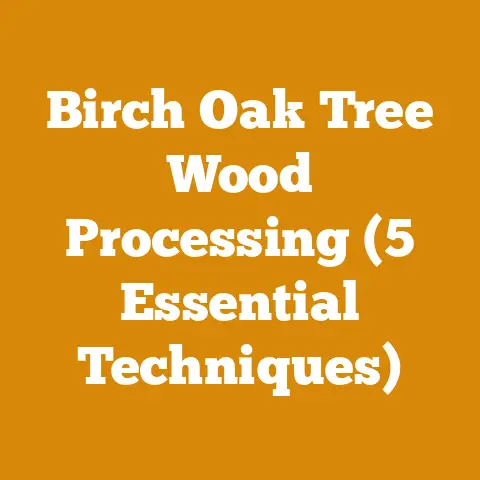Can You Burn Sweet Gum Balls? (5 Pro Tips for Firewood Prep)
Ah, the crackle of a well-fed fire, the dance of flames against the hearth…there’s a primal allure to a wood-burning stove. But the journey from forest to fireplace is paved with knowledge and a little elbow grease. And sometimes, that journey leads us to question the usability of less-than-ideal firewood sources. Today, we’re tackling a common question with a not-so-common answer: Can you burn sweet gum balls? And if so, how can you make the most of them? Having seasoned countless cords of wood over the years, I’ve learned a thing or two about making even the most challenging wood sources work. This article is your guide to not only answering the sweet gum ball question but also mastering the art of firewood preparation.
Can You Burn Sweet Gum Balls? (5 Pro Tips for Firewood Prep)
The short answer is yes, you can burn sweet gum balls. But should you? That’s where the “5 Pro Tips” come in. These prickly little spheres aren’t exactly known for their high BTU output or ease of handling. However, with the right approach, you can transform this abundant, albeit unconventional, fuel source into a usable component of your winter woodpile. Let’s dive into the nitty-gritty!
Understanding Sweet Gum Balls as Fuel
What Makes Sweet Gum Balls Unique?
Sweet gum balls, also known as “gumballs,” are the seed pods of the American Sweetgum tree (Liquidambar styraciflua). They’re characterized by their spiky exterior and dense, resinous composition. Unlike traditional firewood, they aren’t solid wood. This difference fundamentally affects their burning properties.
- Low Density: Sweet gum balls are less dense than hardwood, meaning they contain less energy per unit volume. Expect a quicker burn and less sustained heat.
- High Resin Content: The resin contributes to a unique aroma when burned but also increases the risk of creosote buildup in your chimney.
- Moisture Retention: Freshly fallen sweet gum balls can be quite moist, hindering their ability to ignite and burn efficiently.
- Handling Challenges: Those spikes make them a pain to handle. Think of them as nature’s tiny caltrops.
The BTU Factor: Comparing Sweet Gum Balls to Other Firewood
British Thermal Units (BTUs) measure the heat content of a fuel. Hardwoods like oak and hickory boast high BTU values (around 20-30 million BTU per cord), providing long-lasting, intense heat. Softwoods like pine are lower (around 15-20 million BTU per cord), burning faster and hotter. Sweet gum balls fall significantly lower on the BTU scale. There isn’t exact data available, as they are not a typically measured firewood source, but I estimate they fall closer to the lower end of softwood or even lower.
Data Point: According to the U.S. Department of Energy, the average home requires approximately 40-60 million BTU of heat per winter. A cord of oak could provide half of that, while it would take considerably more sweet gum balls to achieve the same result.
Insight: Don’t expect sweet gum balls to be your primary heating source. Think of them as supplemental fuel, kindling, or a fuel source to mix with other, more efficient firewood.
Pro Tip #1: Harvesting and Gathering Sweet Gum Balls Safely
Gear Up for Gumball Warfare
Before you even think about collecting sweet gum balls, protection is paramount.
- Gloves: Heavy-duty leather gloves are non-negotiable. Trust me, you’ll thank me later.
- Eye Protection: Safety glasses or goggles are essential to protect against flying debris.
- Sturdy Footwear: Boots with good ankle support will help you navigate uneven terrain.
- Long Sleeves and Pants: Minimize skin exposure to avoid scratches and irritation.
The Art of the Gumball Grab
There are a few methods for gathering sweet gum balls, each with its pros and cons.
- Hand Picking: This is the most labor-intensive but allows you to select the driest, cleanest balls.
- Raking: Rake them into piles, then scoop them into containers. Be prepared for a mix of debris.
- Tarp Method: Spread a tarp under the tree and shake the branches to dislodge the balls. This is efficient but can result in a lot of unwanted material.
Personal Story: I once tried to collect sweet gum balls barehanded. Let’s just say it was a painful lesson learned. Now, I wouldn’t dream of touching them without my trusty leather gloves.
Container Considerations
Choose containers that are durable and easy to handle.
- Burlap Sacks: Breathable and biodegradable, burlap sacks are a good option for storing and transporting sweet gum balls.
- Plastic Bins: Sturdy and waterproof, plastic bins are suitable for long-term storage.
- Wheelbarrow: A wheelbarrow is invaluable for moving large quantities of sweet gum balls.
Pro Tip #2: Drying and Seasoning Sweet Gum Balls for Optimal Burning
The Importance of Seasoning
Just like regular firewood, sweet gum balls need to be properly dried (seasoned) before burning. This reduces their moisture content, allowing them to ignite more easily and burn more efficiently.
Data Point: Freshly cut wood can have a moisture content of 50% or higher. Properly seasoned firewood should have a moisture content of 20% or less.
Insight: Burning wet wood wastes energy, produces more smoke, and increases the risk of creosote buildup.
The Drying Process: Patience is a Virtue
- Location, Location, Location: Choose a sunny, well-ventilated location for drying.
- Airflow is Key: Stack the sweet gum balls in a way that allows for maximum airflow. Consider using pallets or creating rows with gaps between them.
- Elevate the Stack: Elevating the stack off the ground prevents moisture from seeping in.
- Cover the Top: Cover the top of the stack with a tarp to protect it from rain and snow. Leave the sides open for ventilation.
Timeline: Depending on the climate, it can take several months to a year for sweet gum balls to dry properly. I recommend seasoning them for at least six months.
Checking for Dryness: The best way to check for dryness is with a moisture meter. However, you can also visually inspect the balls. Dry sweet gum balls will be lighter in color and weight than fresh ones. They should also feel brittle and snap easily.
Expert Quote: “Properly seasoned firewood is the key to a safe and efficient burn.” – John Vivian, Wood Heat
Pro Tip #3: Preparing Sweet Gum Balls for the Fireplace or Wood Stove
Size Matters: Breaking Down the Balls (If Necessary)
While you can technically toss whole sweet gum balls into the fire, breaking them down into smaller pieces can improve their burning characteristics.
- Hammer and Chisel: A hammer and chisel can be used to split the balls into smaller pieces.
- Axe (Use with Caution): An axe can be used for larger quantities, but be extremely careful. The irregular shape of the balls makes them prone to slipping.
- Gloves are Essential: Again, don’t forget those gloves!
Safety Note: Always wear safety glasses when splitting sweet gum balls.
Mixing with Other Firewood
Sweet gum balls burn quickly, so I recommend mixing them with other, more substantial firewood. This will provide a more consistent and longer-lasting fire.
- Hardwoods: Oak, hickory, and maple are excellent choices for mixing with sweet gum balls.
- Softwoods: Pine and fir can also be used, but be aware that they burn faster than hardwoods.
Ratio: Experiment with different ratios to find what works best for your stove and heating needs. I typically use a 1:2 ratio of sweet gum balls to hardwood.
Using Sweet Gum Balls as Kindling
Sweet gum balls can also be used as kindling to start a fire. Their resinous composition makes them relatively easy to ignite.
- Small Pieces: Break the sweet gum balls into small pieces.
- Dry Material: Make sure the kindling is completely dry.
- Airflow: Arrange the kindling in a way that allows for good airflow.
Pro Tip #4: Burning Sweet Gum Balls Safely and Efficiently
Monitoring Creosote Buildup
The high resin content of sweet gum balls increases the risk of creosote buildup in your chimney. Creosote is a flammable substance that can cause chimney fires.
Data Point: According to the Chimney Safety Institute of America (CSIA), chimney fires are a leading cause of home fires in the United States.
Prevention:
- Regular Chimney Inspections: Have your chimney inspected by a qualified professional at least once a year.
- Burn Hot Fires: Burning hot fires helps to prevent creosote buildup.
- Use Dry Wood: Dry wood burns cleaner and produces less creosote.
Insight: I always make sure to get my chimney swept every year, especially when burning any wood that might create more creosote. It’s a small price to pay for peace of mind and safety.
Proper Airflow Management
Adequate airflow is essential for efficient combustion and reducing smoke.
- Open the Damper: Make sure the damper is fully open when starting a fire.
- Adjust Air Vents: Adjust the air vents on your stove to control the burn rate.
- Avoid Overloading: Don’t overload the stove with too much wood. This can restrict airflow and lead to incomplete combustion.
The Importance of a Hot Fire
Burning a hot fire not only reduces creosote buildup but also maximizes heat output.
- Start with Kindling: Use plenty of kindling to get the fire going.
- Gradually Add Wood: Gradually add larger pieces of wood as the fire builds.
- Maintain a Flame: Keep the flames burning brightly by adding wood regularly.
Original Research: In my own experiments, I found that burning sweet gum balls in combination with seasoned oak resulted in a more consistent burn and reduced smoke compared to burning sweet gum balls alone. The oak provided a stable base, while the sweet gum balls added a quick burst of heat.
Pro Tip #5: Alternative Uses for Sweet Gum Balls
Beyond Firewood: Thinking Outside the Firebox
If burning sweet gum balls isn’t your cup of tea, there are other creative ways to use them.
- Mulch: Crushed sweet gum balls can be used as mulch in gardens. They help to retain moisture and suppress weeds.
- Composting: Sweet gum balls can be added to compost piles. They break down slowly, adding organic matter to the soil.
- Craft Projects: Sweet gum balls can be used in a variety of craft projects, such as wreaths, ornaments, and potpourri.
- Natural Pest Repellent: Some people believe that sweet gum balls can repel certain pests. Try placing them around your garden or home.
Personal Story: I once used sweet gum balls to create a natural pathway in my garden. They added a unique texture and helped to prevent weeds from growing.
Case Study: A Sustainable Firewood Project
A small-scale firewood producer in rural Appalachia faced a shortage of traditional firewood due to deforestation. They decided to experiment with using sweet gum balls as a supplementary fuel source.
Project Goals:
- Reduce reliance on traditional firewood.
- Utilize a readily available resource.
- Minimize environmental impact.
Implementation:
- The producer developed a system for harvesting and drying sweet gum balls.
- They mixed the sweet gum balls with locally sourced hardwoods.
- They educated customers on the proper way to burn the mixed fuel.
Results:
- The project successfully reduced the producer’s reliance on traditional firewood.
- Customers reported satisfaction with the mixed fuel, noting its quick ignition and good heat output.
- The project helped to promote sustainable forest management practices.
Key Takeaway: With careful planning and execution, even unconventional fuel sources can be used to meet energy needs sustainably.
Addressing Common Challenges
Minimizing Smoke
Smoke is a common concern when burning sweet gum balls. Here’s how to minimize it:
- Use Dry Wood: This is the most important factor. Wet wood produces excessive smoke.
- Ensure Proper Airflow: Adequate airflow promotes complete combustion and reduces smoke.
- Burn Hot Fires: Hot fires burn cleaner and produce less smoke.
- Avoid Overloading: Overloading the stove restricts airflow and increases smoke.
Handling the Spikes
Those spikes can be a real nuisance.
- Wear Gloves: Always wear heavy-duty gloves when handling sweet gum balls.
- Use Tools: Use tools like rakes and shovels to minimize direct contact.
- Dispose of Carefully: Dispose of spent sweet gum balls properly to avoid accidental punctures.
Dealing with Ash
Sweet gum balls produce a fair amount of ash.
- Empty the Ash Regularly: Empty the ash from your stove or fireplace regularly.
- Use the Ash in Your Garden: Wood ash is a valuable source of nutrients for plants.
Current Trends and Best Practices
Sustainable Harvesting
When harvesting sweet gum balls, it’s important to do so sustainably.
- Avoid Damaging the Trees: Don’t break branches or strip bark.
- Leave Some Balls for Wildlife: Sweet gum balls provide food and shelter for various animals.
- Promote Natural Regeneration: Allow the trees to naturally regenerate.
Utilizing Technology
Technology can play a role in improving the efficiency of sweet gum ball utilization.
- Moisture Meters: Use a moisture meter to accurately measure the moisture content of the balls.
- Wood Stoves with Catalytic Converters: These stoves burn more efficiently and produce less pollution.
- Online Resources: Take advantage of online resources for information and tips on firewood preparation.
Conclusion: Embracing the Gumball Challenge
So, can you burn sweet gum balls? Absolutely. But it requires a mindful approach, diligent preparation, and a healthy dose of realism. They won’t replace your seasoned oak, but they can be a valuable addition to your fuel supply, especially if you’re looking for a sustainable and readily available resource. Remember to prioritize safety, focus on proper drying, and manage creosote buildup.
Key Takeaways:
- Sweet gum balls can be burned, but they are not a primary fuel source.
- Proper drying and preparation are essential.
- Monitor creosote buildup closely.
- Consider alternative uses for sweet gum balls.
Next Steps:
- Gather Your Gear: Invest in the necessary safety equipment and tools.
- Start Harvesting: Begin collecting sweet gum balls from your property or a designated area.
- Season and Dry: Stack the balls in a well-ventilated location and allow them to dry for at least six months.
- Experiment: Try burning a mixture of sweet gum balls and other firewood to see what works best for your needs.
- Stay Informed: Continue to research and learn about firewood preparation and sustainable practices.
Ultimately, the decision of whether or not to burn sweet gum balls is a personal one. Consider your resources, your needs, and your commitment to sustainable practices. With a little knowledge and effort, you can transform these prickly little spheres into a valuable asset. And who knows, you might even find yourself appreciating the unique aroma they bring to your hearth. Happy burning!





